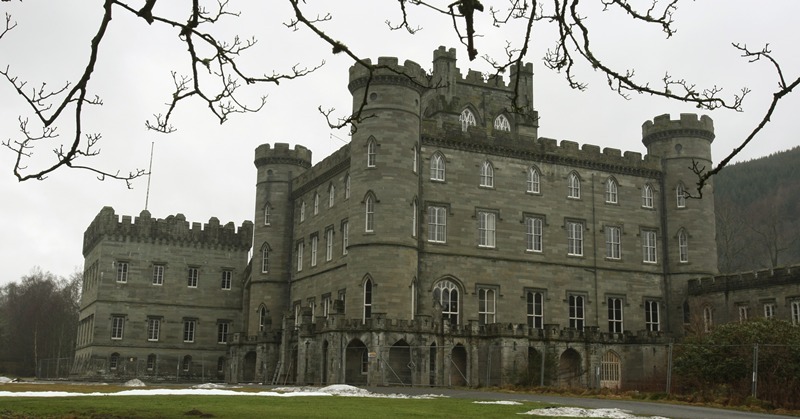The Perthshire castle where a young Queen Victoria honeymooned is to be restored to its former splendour.
Mr Mortimer said, “We have got back the original lights and they will be replaced. When the hotel was put in receivership, these items were put into storage and had to be retrieved and paid for separately. We wanted to bring back some of the original features to the castle.”
As well as rediscovering the former beauty of the castle, the developers have uncovered hidden secrets within the grounds. While clearing paths and bridleways in a bid to open to the public, a number of follies have been found. They include Maxwell’s Temple, Apollo’s Temple and a dairy reportedly built for Queen Victoria so she could try milking a cow. The building, which was used only a handful of times by the monarch, was creating using quartz mined in the Kenmore area.
The development will follow the same pattern by using local materials where possible, as well as local labour. The team working on the site includes up to 20 people from the Kenmore and Aberfeldy area, with more jobs expected to be created when Taymouth Castle reopens.
One Aberfeldy man playing a particularly important role in the project is Eric Strickland from McKenzie Strickland Associates. He was approached by Meteor as he had worked on the application in 2005.
“I got asked to look at being responsible for the architectural side of things,” he said. “We were obviously delighted at doing that because it’s great to have the opportunity to be involved in this. It’s a hugely exciting project for us and we have 11 members of staff working full-time on it at the moment.
“Although it’s a commercial development, there’s a genuine passion to finally see life being breathed back into this castle. When work first started on it, it was like you could almost hear the building saying, ‘Someone loves me again,’ and that is a great feeling.”
Much of the work is being carried out under the planning consent granted in 2005, although research has shown it is not commercially viable in the current economic environment. One of the most important factors for Meteor is ensuring the project will succeed well into the future.
“We are taking our time to really study this carefully and essentially to make the whole thing viable and sustainable,” said Mr Mortimer. “The economy hasn’t been great the last four or five years, so we need to get it right by taking a more straightforward approach.”
The famous monarch’s love for her husband and Scottish Highlands blossomed during her visit to Taymouth Castle, near Kenmore, in 1840.
Despite this royal seal of approval, the gothic building has fallen into disrepair in recent times, with ambitious plans to turn it into a luxury hotel failing to come to fruition.
The original £74 million development of the site foundered when previous owners Taymouth Group Ltd went into administration almost two years ago.
Work had already begun in 2005 to transform the A-listed castle the former seat of the Campbells of Breadalbane into a six-star 150-room hotel with lodges, health spa, tennis courts, equestrian centre and golf course. However, after replacing hundreds of windows and making the building watertight, the developers ran into difficulties.
Now, London’s Meteor Property Fund is hoping to breathe new life into these proposals by introducing its own “credit crunch friendly” development, created by Aberfeldy architects McKenzie Strickland Associates.
To fund the restoration, the firm needs to build on the grounds 71 additional estate properties, which will be constructed in phases. The owners of these and other estate properties will pay an annual service charge to ensure the maintenance and management of the castle and estate.
While planning permission had already been granted for the lodges, the design has been altered by Meteor as it felt the original buildings were too “boxy”. It is hoped the contemporary “pointed” designs will be seen to blend in better with the landscape, as they will be built using locally-sourced material and high-quality glass.
As well as taking part in active estate management to bring the castle and grounds into a better state of repair, the trust fund has other plans in the offing.
The main focus is going to be bringing the James Braid-designed golf course up to championship standard in time for the Ryder Cup in 2014. With the help of Scotland’s number one golfer, Stephen Gallacher, the trust fund hopes to bring back many of the original design features lost over time.
Development manager for Meteor Martin Mortimer said, “It is a classic course but it needs investment because it has had nothing done to it for over 100 years. We will be retaining the great characteristics of the course, as well as increasing the length of it to just over 7000 yards.
“The key thing for us is that our investment has been geared towards the Ryder Cup because there is a huge amount of interest in this area geographically. To get everything ready for then and ensure maximum exposure is very important.”
The original timber golf clubhouse will be replaced with a state-of-the-art one.
Mr Mortimer said, “Interest in the existing clubhouse has been expressed by the local cricket club, so when that is removed from the site it will be donated to them.”
Although this work is not expected to begin until later this year if planning permission is granted behind-the-scenes improvements have already been completed. All of the Chinese Lounge has been restored and the scaffolding was to come down from the main tower this week, following extensive repairs to the ceiling.
The Banner Hall ceiling has also been cleaned, with hundreds of years of soot and grime giving way to the gilded beauty of J. G. Crace.
Despite many of the fixtures and fittings being sold off when Taymouth Group Ltd went into administration, Meteor has tracked down many pieces.
Continued…
